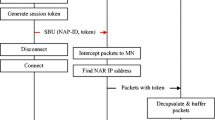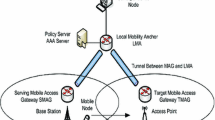Abstract
The growing demand for seamless invocation of different multimedia services from handheld devices anytime anywhere is the main driving force for drawing attention in the area of mobility management. Although Session Initiation Protocol (SIP) based mobility solution is very efficient for real-time services, Mobile IP is required to handle mobility of the mobile node (MN) at the network layer. We have extensively studied and explored some existing mobility management methods integrating the functionalities of Mobile IP and SIP in this paper. These schemes require support of IP encapsulation at the protocol stack of correspondent node (CN). To address the above problem, we have proposed in this paper, certain modification at the IP layer of Base Station (BS) that also reduces the bandwidth consumption. Moreover, service provisioning in a continuous way in public places like airport, university campus etc., requires to integrate some micro-mobility protocol with the existing mobility management methods to reduce the handoff disruption time in case of intradomain handoff. Thus, in this paper, we have proposed two new hybrid mobility management schemes that integrate two existing Mobile IP and SIP-based schemes where the proposed modification in the IP layer of BS is incorporated separately with the micro-mobility protocol Hierarchical Mobile IP (HMIP). The numerical results show that the integration of HMIP into the existing methods reduces both the signaling cost and the delay, mainly the active handoff disruption time. Simulation results on NS-2 demonstrate the performance improvement of the proposed mobility management schemes over the existing methods in terms of handoff delay.
Similar content being viewed by others
References
Perkins, C. (2002). IP Mobility Support for Ipv4. Request for Comments (Proposed Standard) 3344, Internet Engineering Task Force, Aug.
Perkins, C. E., & Johnson, D. B. (2000). Route Optimization in Mobile IP. IETF Internet draft, draft-ietf-mobileip-optim-09.txt (work in progress), Feb.
Perkins, C. (1996). IP encapsulation within IP. Request for Comments (Proposed Standard) 2003, IETF, Oct.
Schulzrinne, H., & Wedlund, E. (2000). Application-layer mobility using SIP. Mobile Computing and Communications Review, 4(3), 47–57.
Rosenberg, J., Schulzrinne, H. et al. (2002). SIP UA (SIP User Agent). SIP: Session Initiation Protocol. Network Working Group, Request for Comments: 3261, June, p. 25.
Rosenberg, J., Schulzrinne, H. et al. (2002). SIP HR (SIP Home Registrar). SIP: Session Initiation Protocol. Network Working Group, Request for Comments: 3261, June, p. 56.
Nakajima, N., Dutta, A. et al. (2003). Handoff delay analysis and measurement for SIP based mobility in IPv6. In Proceedings of IEEE international conference on communications (ICC 2003) (Vol. 2, pp. 1085–1089).
Wedlund, E. & Schulzrinne, H. (1999). Mobility support using SIP. In Second ACM/IEEE international conference on wireless and mobile multimedia (WoWMoM’99) (pp. 76–82), Seattle, Washington, Aug.
Rosenberg, J., Schulzrinne, H. et al., SIP Proxy Server (2002). SIP: Session Initiation Protocol. Network Working Group, Request for Comments: 3261, June, p. 91.
Lee, H., Song, J., Lee, S., & Cho, D. (2005). Integrated mobility management methods for mobile IP and SIP in IP based wireless data networks. Wireless Personal Communications, 35(33), 269–287.
Perkins, C., Co-located CoA (2002). IP Mobility Support for IPv4. Request for Comments (Proposed Standard) 3344, Internet Engineering Task Force, Aug., p. 83.
Politis, C., Chew, K. A., Akhtar, N., Georgiades, M., Tafazolli, R., & Dagiuklas, T. (2004). Hybrid multilayer mobility management with AAA context transfer capabilities for All-IP networks. IEEE Wireless Communications, 11(4), 76–88.
Srisuresh, P. et al. (1999). IP Network Address Translator (NAT) terminology and consideration. Network Working Group, Request for Comments 2663, Aug.
Rosenberg, J., Weinberger, J., Huitema, C., & Mahy, R. (2003). STUN—simple traversal of User Datagram Protocol (UDP) through Network Address Translators (NATs). Request for Comments: 3489, March.
Gustaffson, E., Jonsson, A., & Perkins, C. (2007). Mobile IPv4 regional registration. Request for Comments (Experimental) 4857, June.
The Network Simulator (NS-2) (2004). http://www.isi.edu/nsnam/ns/, release 2.27, Jan.
Author information
Authors and Affiliations
Corresponding author
Rights and permissions
About this article
Cite this article
Sadhukhan, P., Das, P.K. & Saha, S. Hybrid mobility management schemes integrating mobile IP and SIP for seamless invocation of services in All-IP network. Telecommun Syst 52, 2027–2046 (2013). https://doi.org/10.1007/s11235-011-9483-7
Published:
Issue Date:
DOI: https://doi.org/10.1007/s11235-011-9483-7




